Preparing for the Mathematics Diagnostic Test for Placement Test at UVI
Preparing for the Mathematics Diagnostic Test for Placement Test at UVI
Information to assist students in preparing to avoid
the necessity of taking a non-credit mathematics course
A student who enters the University of the Virgin Islands with an SAT-M score
below 490 is
automatically placed in the Math Skills courses, MAT 023 – 024 unless the
student
demonstrates competence in essential mathematics skills on UVI’s Mathematics
Diagnostic and
Placement Test.
The Mathematics test is administered to incoming students as a diagnostic tool.
If you received
adequate mathematics preparation in high school, you should review that
mathematics now,
brush up on your skills and be ready to demonstrate your proficiency on the
diagnostic test for
placement so that you do not waste your education dollars or your precious time
by repeating
your high school mathematics. For those students who are placed in the Math
Skills program,
the test helps your instructor to understand your mathematics needs.
This website contains the type of questions you should be able to answer at
about
the level you can expect on the placement tests.
You may print the contents to make it easier for you to work with the questions.
Questions to assess your understanding of numbers and
basic arithmetic operations .
You must be able to perform simple examples of the operations of addition ,
subtraction,
multiplication and division on fractions, decimals and integers without a
calculator. Of
even more importance, you must be able to demonstrate that you know what these
numbers mean.
Let us begin with meaning; some might call this number sense.
You probably have a good understanding of the number
 . You could shade
. You could shade
 of this
of this
box.

You could mark the number
 in the appropriate position on this number
line.
in the appropriate position on this number
line.

You could graph the point
 on this coordinate plane .
on this coordinate plane .
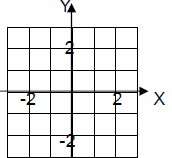
You need to be able to answer similar questions with
other fractions.
The answers begin on page 9.
Do the following:
1. Shade in  of the box above. Explain why
your shading illustrates the number
of the box above. Explain why
your shading illustrates the number  .
.
2. Mark the point that represents the number
 on the number line above . Be as
on the number line above . Be as
accurate as you can. Explain why the point belongs in the position you chose.
3. Mark the point  on the coordinate plane.
on the coordinate plane.
4. Mark the point that represents the number  on the number line. Be as accurate as
on the number line. Be as accurate as
you can.
5. Mark the point  on the coordinate plane.
Be as accurate as you can.
on the coordinate plane.
Be as accurate as you can.
Next, we consider arithmetic operations.
You need to know how to add, subtract, multiply and divide fractions . You also
need to
understand the meaning of these operations. Computations will not be any harder
than
the types listed below. Try these.
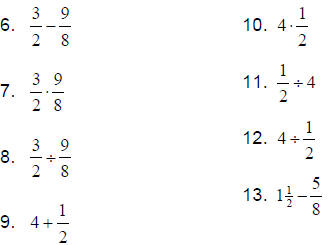
14. Use the diagram below to explain the subtraction in
question 6 by doing the following:
Shade the diagram to illustrate  using one
color. Shade the diagram to illustrate
using one
color. Shade the diagram to illustrate
using a different color . Then explain which part of the diagram is represented
by the
subtraction  .
.

15. Explain the difference between the meaning of
questions 9 and 10. Use a real world
example or else a diagram.
16. Explain the difference between the meaning of questions 11 and 12. What
might it
mean if you had “half a banana” and you “divided by 4”? What might it mean if
you had
“4 bananas” and you “divided by ½”?
You need to know how to operate on decimals . If you understand the meaning of
the
numbers, you won’t make any major errors. Remember, no calculators will be
allowed;
you actually need to think about these!
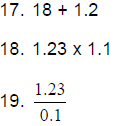
You must be able to perform simple operations on
integers without recourse to a
calculator. Test yourself on the following examples.
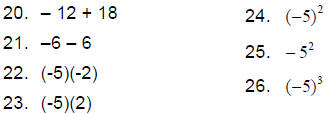
Questions to assess your understanding of percents and
other ratios .
Percents give us a common language for comparing amounts. You should be able
to
relate percents to equivalent fractions and decimals. Try these. Give
corresponding
values in each column.
| Percent | Decimal | Fraction |
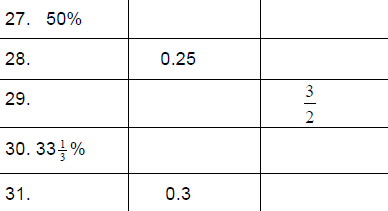 |
||
Some questions, like the next three, may require
analysis of a situation. In general, you
will be expected to show your work. These three use the concept of ratio,
sometimes as a
percent and sometimes not. You should be able to think through these easily.
32. If you are being paid $10 an hour and get a raise that will increase your
hourly rate by
10%, what will your hourly wage be then?
33. A newspaper reporter wishes to report that 40 students from a group of 200
students
who were chosen to receive a special award came from his school district by
stating
the number as a percent. What percent of the 200 students are from his district?
34. If the amount of rum needed for 10 gallons of a recipe for punch is 2
liters, how much
rum would you need for the same punch if you only wanted to make 2 gallons of
punch?
| Prev | Next |